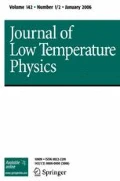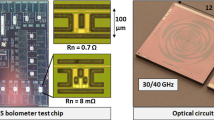Abstract
We review advances in low-temperature detector (LTD) arrays for cosmic microwave background (CMB) polarization experiments, with a particular emphasis on imaging arrays. We briefly motivate the science case, which has spurred a large number of independent experimental efforts. We describe the challenges associated with CMB polarization measurements, and how these challenges impact LTD design. Key aspects of an ideal CMB polarization imaging array are developed and compared to the current state of the art. These aspects include dual-polarization sensitivity, background-limited detection over a 10:1 bandwidth ratio, and frequency-independent angular responses. Although existing technology lacks all of this capability, today’s CMB imaging arrays achieve many of these ideals and are highly advanced superconducting integrated circuits. Deployed arrays map the sky with pixels that contain elements for beam formation, polarization diplexing, passband definition in multiple frequency channels, and bolometric sensing. Several detector architectures are presented. We comment on the implementation of both transition-edge sensor bolometers and microwave kinetic inductance detectors for CMB applications. Lastly, we discuss fabrication capability in the context of next-generation instruments that call for \(\sim 10^6\) sensors.








Similar content being viewed by others
Notes
This calculation assumes that photon noise from the CMB is the only noise source and that the noiseless detector perfectly couples to a single electromagnetic mode over the frequency range 125–165 GHz.
This calculation depends slightly on the Lyot stop temperature.
References
Planck Collaboration, Astron. Astrophys. 571 (2014)
T. Matsumura et al., J. Low Temp. Phys. 176, 5–6 (2014)
A. Challinor, Proc. Int. Astron. Union 8, S288 (2012)
K.N. Abazajian et al. (2016). arXiv:1610.02743
M. Kamionkowski, E.D. Kovetz, Ann. Rev. Astron. Astrophys. 54 (2016). arXiv:1510.06042
F. Finelli et al., J. Cosmol. Astropart. Phys. 4, 016 (2018). arXiv:1612.08270
E. Di Valentino et al. J. Cosmol. Astropart. Phys. 4 (2018). arXiv:1612.00021
A. Challinor et al. J. Cosmol. Astropart. Phys. 4 (2018). arXiv:1707.02259
J.-B. Melin et al. J. Cosmol. Astropart. Phys. 4 (2018). arXiv:1703.10456
U. Seljak, Astrophys. J. 482, 1 (1997)
M. Kamionkowski, A. Kosowsky, A. Stebbins, Phys. Rev. Lett. 78, 11 (1997)
U. Seljak, M. Zaldarriaga, Phys. Rev. Lett. 78, 11 (1997)
K.D. Irwin, G.C. Hilton, Cryogenic Particle Detection (Springer, Berlin, 2005), pp. 63–150
P.K. Day et al., Nature 425, 817 (2003)
J. Baselmans, J. Low Temp. Phys. 167, 3–4 (2012)
Simons Observatory. https://simonsobservatory.org/. Accessed 1 Aug 2017
J.A. Grayson et al. in SPIE Conference Series, vol. 9914 (2016). arxiv:1607.04668
Y.-P. Li et al. (2017). arXiv:1709.09053
M.H. Abitbol et al. (2017). arXiv:1706.02464
Planck Collaboration, Astron. Astrophys. 594 A13 (2016)
T. Louis et al., J. Cosmol. Astropart. Phys. 2017, 06 (2017)
R. Keisler et al., Astrophys. J. 807, 2 (2015)
A. Crites et al., Astrophys. J. 805, 1 (2015)
D. Hanson et al., Phys. Rev. Lett. 111(14), 141301 (2013). arXiv:1307.5830
P.A. Ade et al., Phys. Rev. Lett. 116, 3 (2016)
P. Ade et al., Astrophys. J. 794, 2 (2014)
P. Ade et al. (2017). arXiv:1705.02907
D. O’Dea, A. Challinor, B.R. Johnson, Mon. Not. R. Astron Soc. 376, 4 (2007)
M. Shimon et al., Phys. Rev. D 77, 8 (2008)
P.F. Goldsmith, Quasioptical Systems: Gaussian Beam Quasioptical Propagation and Applications (IEEE Press, New York, 1998)
J.W. Lamb, Int. J. Infrared Millim. Waves 17, 12 (1996)
M. Remazeilles et al., J. Cosmol. Astropart. Phys. 2018, 04 (2018)
Planck Collaboration, Astron. Astrophys. 594, A10 (2016)
C.L. Kuo et al. in SPIE Conference Series, vol. 7020 (2008). arXiv:0908.1464
R. O’Brient et al. in SPIE Conference Series, vol. 8452 (2012). arXiv:1208.1247
K. Yoon et al. in AIP Conference Proceedings, vol. 1185. AIP (2009)
D.T. Chuss et al., J. Low Temp. Phys. 167, 5–6 (2012)
K. Arnold et al. in SPIE Conference Series, vol. 8452 (2012). arXiv:1210.7877
J. Zmuidzinas, Appl. Opt. 42, 25 (2003)
R.W. Boyd, Infrared Phys. 22, 3 (1982)
J. Errard et al., J. Cosmol. Astropart. Phys. 2016, 03 (2016)
Planck HFI Core Team, Astron. Astrophys. 536, A4 (2011). arXiv:1101.2039
J. Delabrouille et al., J. Cosmol. Astropart. Phys. 4, 014 (2018)
R. Gualtieri et al., J. Low Temp. Phys. 184, 3–4 (2016)
P.C. Nagler et al. (2016). arXiv:1611.04466
E. Grace et al., in SPIE Conference Series 9153 (2014)
R.J. Thornton et al., Astrophys. J. Suppl. Ser. 227 (2016). arXiv:1605.06569
P.A. Ade et al., Astrophys. J. 792, 1 (2014)
J.E. Austermann et al., in SPIE Conference Series, vol. 8452 (2012). arXiv:1210.4970
P.A. Ade et al., Astrophys. J. 811, 2 (2015)
K. Arnold et al., in SPIE Conference Series, vol. 7741 (2010)
R. Datta et al., J. Low Temp. Phys. 176 (2014). arXiv:1401.8029
J. Hubmayr et al., 26th Int. ISSTT (2015)
A. Suzuki et al., J. Low Temp. Phys. 167, 5–6 (2012)
R. Datta et al., J. Low Temp. Phys. 184 (2016). arXiv:1510.07797
S. Choi et al., J. Low Temp. Phys. (2018). https://doi.org/10.1007/s10909-018-1982-4
K. Crowley et al., J. Low Temp. Phys., Submitted (2018)
S.-P. P. Ho et al., in SPIE Conference Series, vol. 9914 (2017)
K.T. Crowley et al., in SPIE Conference Series, vol. 9914 (2016)
A.J. Anderson et al., J. Low Temp. Phys. (2018). https://doi.org/10.1007/s10909-018-2007-z
K. Arnold et al., in SPIE Conference Series, vol. 9153 (2014)
J. McMahon et al., J. Low Temp. Phys. 167, 879–884 (2012). arXiv:1201.4124
J. Hubmayr et al., in SPIE Conference Series, vol. 9914 (2016). arXiv:1606.09396
B. Westbrook et al., J. Low Temp. Phys. 184, 1–2 (2016)
C. Posada et al., Superconduct. Sci. Technol. 28, 9 (2015)
Z. Pan et al., J. Low Temp. Phys. (2018). https://doi.org/10.1007/s10909-018-1935-y
M.J. Griffin, J.J. Bock, W.K. Gear, Appl. Opt. 41, 31 (2002)
A. Cukierman et al., Appl. Phys. Lett. 112, 132601 (2018)
S.-F. Lee et al., Appl. Opt. 37, 16 (1998)
J. Zmuidzinas, Annu. Rev. Condens. Matter Phys. 3, 1 (2012)
S.R. Golwala et al., in SPIE Conference Series, vol. 8452 (2012). arxiv:1211.0595
A. Catalano et al., Astron. Astrophys. 569 (2014). arXiv:1402.0260
R. Adam et al., Astron. Astrophys. 609 (2018). arXiv:1707.00908
S. Oguri et al., J. Low Temp. Phys. 184 (2016)
B.R. Johnson et al. (2017). arXiv:1711.02523
Q.Y. Tang et al. (2017). arXiv:1710.11255
A. Dominjon et al., in 2017 16th International Superconductive Electronics Conference (ISEC) (2017)
N. Galitzki et al., J. Astro. Inst. 3, 1440001 (2014). arXiv:1409.7084
A. Lowitz et al., J. Low Temp. Phys. 176, 3–4 (2014)
J.C. Mather, Appl. Opt. 21, 6 (1982)
P. De Visser et al., Phys. Rev. Lett. 106, 16 (2011)
P.J. de Visser et al., J. Low Temp. Phys. 167, 3 (2012)
D. Flanigan et al., Appl. Phys. Lett. 108, 083504 (2016). arXiv:1510.06609
T. Guruswamy, D. Goldie, S. Withington, Superconduct. Sci. Technol. 27, 5 (2014)
P. De Visser et al., Appl. Phys. Lett. 106, 25 (2015)
O. Quaranta et al., Superconduct. Sci. Technol. 26, 10 (2013)
A. Miceli et al., J. Low Temp. Phys. 176, 3 (2014)
B.A. Steinbach et al. (2018). arXiv:1803.06413
J. Gao et al., Appl. Phys. Lett. 92, 21 (2008)
B.R. Johnson et al. (2016). arXiv:1607.03796
C. Ji et al., in SPIE Conference Series 9153 (2014)
A.A. Fraisse et al., J. Cos. Astro. Phys. 4 (2013). arxiv:1106.3087
Z. Staniszewski et al., J. Low Temp. Phys. 167 (2012)
Z. Ahmed et al., in SPIE Conference Series 9153 (2014). arXiv:1407.5928
H. Hui et al., in SPIE Conference Series, vol. 10708 (2018)
H. Li et al. (2018). arXiv:1710.03047
S. Duff et al., J. Low Temp. Phys. 184, 3–4 (2016)
S.K. Choi et al. (2018). arXiv:1711.04841
A.S. Bergman et al. (2017). arXiv:1711.04169
Acknowledgements
We thank Lyman Page, Roger O’Brient, Adam Anderson, and Kam Arnold for figure contributions.
Author information
Authors and Affiliations
Corresponding author
Rights and permissions
About this article
Cite this article
Hubmayr, J., Austermann, J.E., Beall, J.A. et al. Low-Temperature Detectors for CMB Imaging Arrays. J Low Temp Phys 193, 633–647 (2018). https://doi.org/10.1007/s10909-018-2029-6
Received:
Accepted:
Published:
Issue Date:
DOI: https://doi.org/10.1007/s10909-018-2029-6




